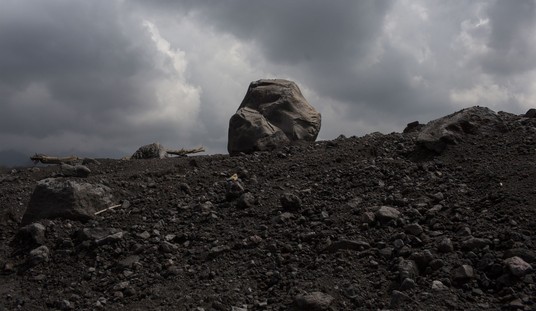I hit two different supermarkets today to load up on bottled water, beer, PB&J, beer, canned goods, and beer. And let me tell you: As of this afternoon, despite the fact that cable-news weathermen are practically shaking on-air while reporting on this thing, the shelves at both locations were still fully stocked. Poland Springs as far as the eye can see. Maybe all that means is that the run on nonperishables is postponed until tonight, once everyone’s off work for the day, or maybe it means people aren’t taking this nearly as seriously as they should. When I called family members this afternoon to see what they’re doing to prepare, they were surprised to hear that there’s something they’re supposed to be preparing for. Dude.
The city’s official hurricane threat level has already been raised from “Hipster-ish Aloofness” to “Annoyance At Being Inconvenienced.” Next step: “Wet Your Pants.”
I am most concerned about the storm surge danger to North Carolina, Virginia, Maryland, Delaware, New Jersey, New York, and the rest of the New England coast. Irene is capable of inundating portions of the coast under 10 – 15 feet of water, to the highest storm surge depths ever recorded. I strongly recommend that all residents of the mid-Atlantic and New England coast familiarize themselves with their storm surge risk. The best source of that information is the National Hurricane Center’s Interactive Storm Surge Risk Map, which allows one to pick a particular Category hurricane and zoom in to see the height above ground level a worst-case storm surge may go. If you prefer static images, use wunderground’s Storm Surge Inundation Maps. If these tools indicate you may be at risk, consult your local or state emergency management office to determine if you are in a hurricane evacuation zone. Mass evacuations of low-lying areas along the entire coast of New Jersey, Delaware, Maryland, and Virginia are at least 50% likely to be ordered by Saturday. The threat to the coasts of New York, Connecticut, Rhode Island, Massachusetts, New Hampshire, and Maine is less certain, but evacuations may be ordered in those states, as well. Irene is an extremely dangerous storm for an area that has no experience with hurricanes, and I strongly urge you to evacuate from the coast if an evacuation is ordered by local officials. My area of greatest concern is the coast from Ocean City, Maryland, to Atlantic City, New Jersey. It is possible that this stretch of coast will receive a direct hit from a slow-moving Category 2 hurricane hitting during the highest tide of the month, bringing a 10 – 15 foot storm surge…
[T]he highest storm surge on record in New York City occurred during the September 3, 1821 hurricane, the only hurricane ever to make a direct hit on the city. The water rose 13 feet in just one hour at the Battery, and flooded lower Manhattan as far north as Canal Street, an area that now has the nation’s financial center. The total surge is unknown from this greatest New York City hurricane, which was probably a Category 2 storm with 110 mph winds. NOAA’s SLOSH model predicts that a mid-strength Category 2 hurricane with 100-mph winds could drive a 15 – 20 foot storm surge to Manhattan, Queens, Kings, and up the Hudson River. JFK airport could be swamped, southern Manhattan would flood north to Canal Street, and a surge traveling westwards down Long Island Sound might breach the sea walls that protect La Guardia Airport. Many of the power plants that supply the city with electricity might be knocked out, or their docks to supply them with fuel destroyed. The more likely case of a Category 1 hurricane hitting at high tide would still be plenty dangerous, with waters reaching 8 – 12 feet above ground level in Lower Manhattan. Given the spread in the models, I predict a 20% chance that New York City will experience a storm surge in excess of 8 feet that will over-top the flood walls in Manhattan and flood the subway system. This would most likely occur near 8 pm Sunday night, when high tide will occur and Irene should be near its point of closest approach. Such a storm surge could occur even if Irene weakens to a tropical storm on its closest approach to New York City.
That’s from Jeff Masters at Weather Underground; the boldface emphases are his, not mine. His latest post suggests a bit of optimism, noting a slight weakening of Irene late this afternoon, but he may have spoken too soon. Brendan Loy, who’s tracking the storm every few hours for Pajamas Media, says in his latest post that the storm now appears to be getting stronger. In fact, NBC’s weatherman in Philadelphia is wondering whether it might reach Category 4. Says Max Mayfield, the former director of the National Hurricane Center, “One of my greatest nightmares was having a major hurricane go up the whole Northeast Coast.” Another expert at the University of South Carolina countered, “In many ways, a Category 2 or stronger storm hitting New York is a lot of people’s nightmare.” At this point, a Category 2 seems like a distinct possibility, if not quite (yet) a probability, and a Category 1 looks very solid. When I’m gone, remember me as I was, my friends — hiding under a blanket, screaming for my mommy.
Late word from Bloomberg’s office is that the entire New York City transit system may be offline for parts of the weekend. Low-lying areas in the five boroughs may also need to be evacuated — but Bloomy’s holding off on that decision until 8 a.m. Saturday, just 24 hours or so before Irene swallows the city. Initially he was supposed to decide by tomorrow night, which Loy, for one, thought was already problematically late. (Bloomberg’s urging coastal residents to leave voluntarily tomorrow.) How much economic fallout are we talking about here potentially? Nate Silver’s model suggests that a direct hit on the City from a Category 4 could mean $200 billion in damage, comparable to Japan’s tsunami. No one’s expecting that — the ‘cane will weaken once it makes landfall in the Carolinas and trudges north through New Jersey — but even a Category 2 could mean $10 billion. But that’s an estimate of direct damage, I believe; James Pethokoukis is already thinking about indirect damage in the form of a new recession as Irene knocks thousands of businesses offline. The flip side: Keynesian stimulus!
Here’s the National Weather Center’s Hurricane page, which is being updated every few hours. If the storm turns west or east, they’ll have it first. And here’s a useful list of precautions to take from Melissa Clouthier, who’s been through a few of these before. Many of them are self-evident — assume no water and no power for five days and imagine what you’d need to survive to get through that — but some are less obvious and potentially important. See, for example, number 18.
Exit question: Why didn’t the animals warn us weeks ago?








Join the conversation as a VIP Member